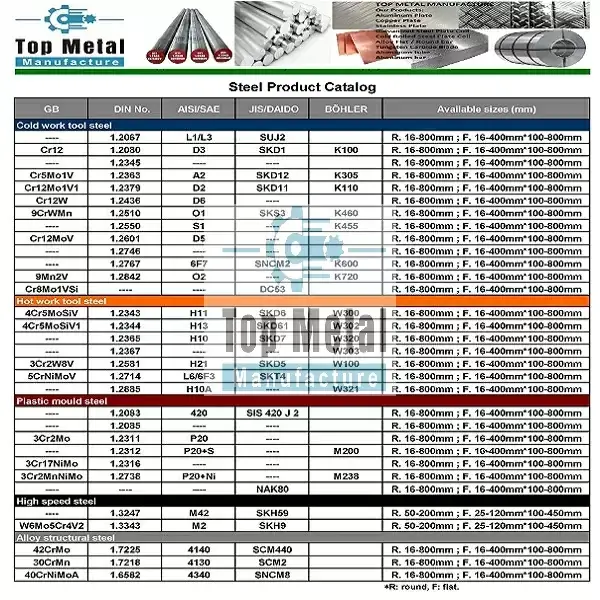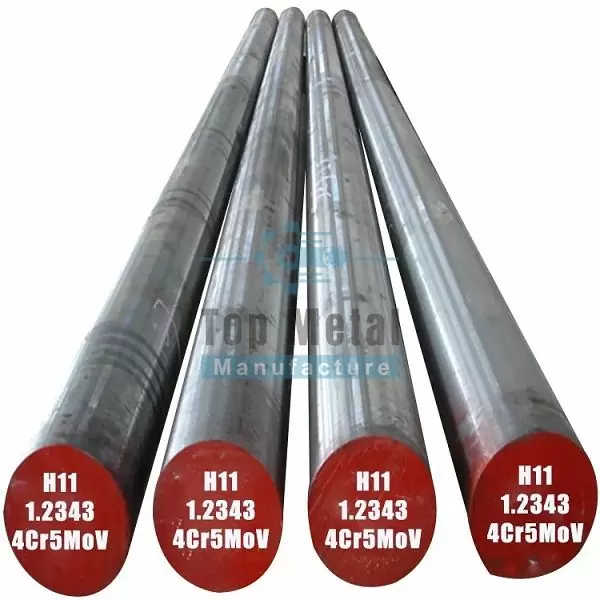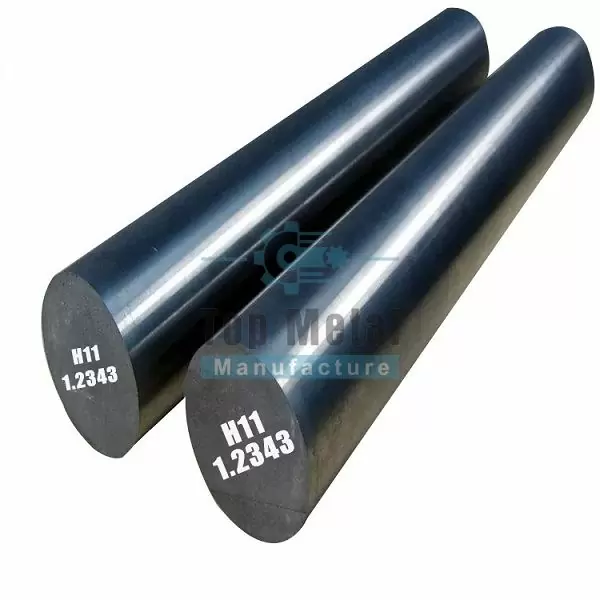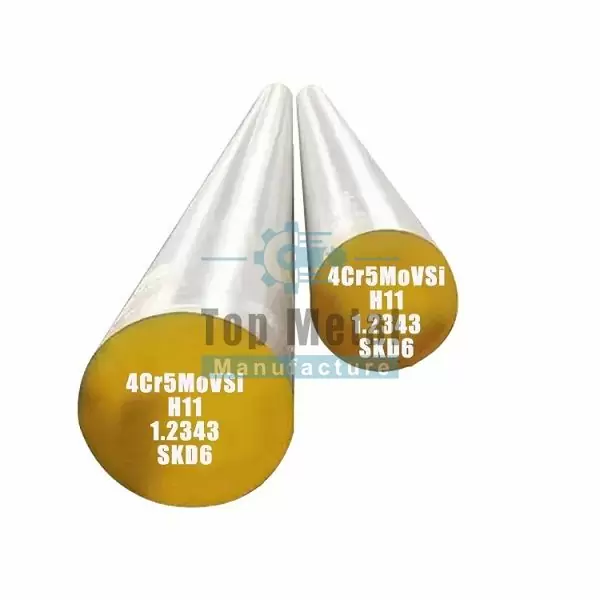L'acier à outils H11 présente une déformation minimale lors du durcissement en profondeur et du durcissement à l'air grâce à la teneur équilibrée en alliage. Le H11 peut également être durci par trempe à l'air.
L'acier à outils H11, équivalent à 882, est un acier à outils de travail à chaud au chrome 5% conçu spécialement pour les applications nécessitant une ténacité extrême associée à une bonne dureté rouge. Il offre une marge de sécurité supplémentaire pour les outils soumis à de violents coups de marteau et les outils contenant des creux profonds ou des angles vifs.
L'acier à outils H11 est forgé à 900-1120°C. Un réchauffage est nécessaire lorsque la température est inférieure à 900°C. L'acier AISI H11 doit être refroidi aussi lentement que possible dans le four. Un recuit est recommandé après le forgeage. Le soulagement des contraintes pour éliminer les contraintes d'usinage doit être effectué en chauffant à 650°C, en maintenant la température pendant une heure, puis en refroidissant dans le four.
Acier à outils H11 de qualité équivalente : AISI H11, SAE H11, H11, 4Cr5MoSiV, DIN 1.2343, JIS SKD6, DAIDO SKD6 BOHLER W300
| Matériel | 1.2343 (Compositions chimiques %) | |||||||
| C Si Mn Cr Mo VP & S | ||||||||
| 0,36-0,42 0,90-1,20 0,30-0,50 4,80-5,80 1,10-1,40 0,25-0,50 ≤0,030 | ||||||||
| Taille | Rond φ20-650 mm ; Plat 20-450×50-810mm | |||||||
| Lieu d'origine | Fabriqué en Chine | |||||||
| Condition de livraison | Forgé/laminé à chaud | |||||||
| Traitement de surface | Noir/broyé/pelé/tourné/broyé/polis/brillant | |||||||
| Traitement thermique | Recuit 2 à 4 fois | |||||||
| Emballage | Emballage navigable ou selon la demande du client | |||||||
| MOQ | 10 tonnes | |||||||
| Délai de livraison | 60 jours | |||||||
| Terme commercial | FOB/CIF/CFR | |||||||
| Conditions de paiement | T/T | |||||||
| Port de chargement | Shanghai | |||||||
Les caractéristiques de formage de l'acier à outils H-11 H11 AMS 6487 sont bonnes par les méthodes conventionnelles. Il peut également être formé par forgeage et usinage. L'acier à outils de soudage H-11 AMS 6487 est un alliage facilement maniable par les méthodes conventionnelles.
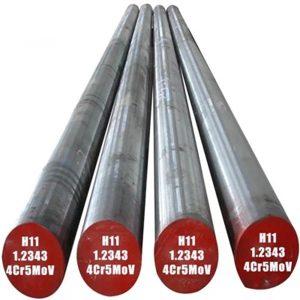
| Acier à outils pour travail à chaud | |
| VACARME | 1.2344,1.2343,1.2365,1.2581,1.2367,1.2714, etc. |
| AISI | H13, H11, H10, H21, L6, etc. |
| JIS | SKD61, SKD6, SKD5, SKT4, etc. |
| Travail à froid aussi en acier | |
| VACARME | 1.2601,1.2379,1.2080,1.2363,1.2842,1.2419,1.2510,1.2550,1.2767, etc. |
| AISI | D2,D3,A2,O2,O1, etc. |
| JIS | SKD1, SKD11, STD12, SKS31, SKS3 etc. |
| Acier de moule en plastique | |
| VACARME | 1.2083,1.2311,1.2312,1.2316,1.2738, etc. |
| AISI | P20, P20+Ni,P20+S,420 etc. |
| JIS | NAK80 |
WORK TOOL STEEL GRADE H11, a member of the hot – work tool steel family, has carved a niche for itself in various industrial applications due to its exceptional properties.
1. Composition chimique
Tool Steel H11 is characterized by a balanced chemical composition. It contains a moderate amount of carbon, typically around 0.33 – 0.43%. Carbon is crucial as it contributes to the steel’s hardness and strength. By carefully controlling the carbon content, H11 can achieve a good balance between wear resistance and toughness.
Chromium (Cr) is present in H11 at approximately 4.75 – 5.50%. Chromium significantly enhances the steel’s hardenability, corrosion resistance, and high – temperature strength. It forms carbide compounds during heat treatment, which play a vital role in strengthening the microstructure of the steel.
Molybdenum (Mo) is another key alloying element in H11, with a content of about 1.10 – 1.75%. Molybdenum improves the steel’s hardenability, creep resistance, and resistance to temper softening. It also helps in reducing the critical cooling rate during quenching, which is beneficial for preventing cracking and distortion.
Vanadium (V) is added in small amounts, around 0.30 – 0.60%. Vanadium forms fine carbide particles that are extremely hard and stable. These carbides enhance the wear resistance and toughness of H11, and also contribute to its ability to maintain its hardness at elevated temperatures.
2. Propriétés mécaniques
Acier à outils H11 exhibits excellent mechanical properties that make it suitable for demanding applications. Its hardness, after proper heat treatment, can reach a Rockwell C scale (HRC) value of around 50 – 55. This high hardness enables the steel to resist wear and deformation during service, ensuring a long – lasting performance in applications such as die – casting dies and forging tools.
La dureté du H11 est également remarquable. Il peut résister à des forces d'impact importantes sans se fracturer, ce qui est crucial dans les applications où l'outil est soumis à des charges de choc répétées. Cette combinaison de dureté et de ténacité est obtenue grâce au contrôle minutieux des éléments d'alliage et du processus de traitement thermique.
In terms of fatigue strength, H11 shows good resistance to cyclic loading. This property is essential for tools that are used in high – cycle operations, as it helps to prevent premature failure due to fatigue cracks.
3. Traitement thermique
Le traitement thermique est un processus essentiel pour que le H11 obtienne ses propriétés optimales. Le processus de traitement thermique typique pour le H11 comprend le recuit, la trempe et le revenu.
Annealing is carried out at around 845 – 870°C followed by slow cooling. This process softens the steel, relieves internal stresses, and improves machinability. It also refines the grain structure, preparing the steel for subsequent heat treatment operations.
Quenching is usually performed at a high temperature, around 1010 – 1050°C, followed by rapid cooling, often in oil or a suitable quenching medium. This high – temperature quenching step is necessary to achieve the desired hardness and strength by transforming the microstructure into a martensitic phase.
Tempering is then carried out at temperatures between 550 – 650°C. Tempering helps to relieve the internal stresses induced during quenching, improves the toughness of the steel, and fine – tunes the hardness to the desired level. Multiple tempering cycles may be employed to further optimize the properties of H11.
4. Applications
Due to its outstanding properties, H11 finds wide applications in the manufacturing industry. In the die – casting industry, acier à outils H11 is commonly used to make dies for casting non – ferrous metals such as aluminum and magnesium. The high – temperature strength and wear resistance of H11 enable the dies to withstand the harsh conditions of the die – casting process, including high pressures and repeated contact with molten metal.
In the forging industry, H11 is used to manufacture forging dies. These dies need to have high strength, toughness, and wear resistance to shape hot – worked metals into the desired forms. H11’s ability to maintain its properties at elevated temperatures makes it an ideal choice for this application.
It is also used in the production of extrusion dies, where the steel must resist the high forces and temperatures associated with pushing metal through a die to form various shapes. Additionally, H11 can be found in some plastic injection molds, especially those used for high – temperature plastics or in applications where long – term wear resistance is required.
Autres matériaux en acier à outils disponibles
